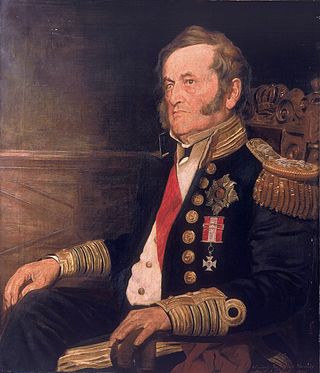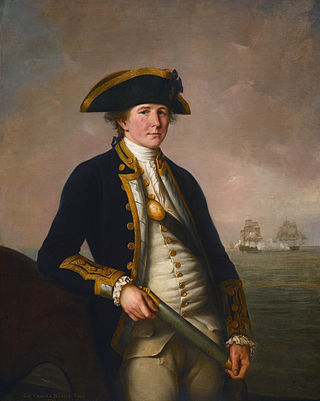
Admiral of the Fleet Sir Provo William Parry Wallis, was a Royal Navy officer. As a junior officer, following the capture of USS Chesapeake by the frigate HMS Shannon during the War of 1812, the wounding of HMS Shannon's captain and the death of her first lieutenant in the action, he served as the temporary captain of HMS Shannon as she returned to Halifax, Nova Scotia, with Chesapeake.

Admiral of the Fleet Sir Fairfax Moresby GCB was a Royal Navy officer. As a junior officer he took part in the unsuccessful expedition to capture Ferrol in Spain during the French Revolutionary Wars. He later saw action during the blockade of Brest during the Napoleonic Wars before becoming commanding officer of a sloop which was sent to the Aegean Sea to defend the population of Malta from pirates; the grateful people presented him with a sword. He then sailed to the Adriatic Sea where he led a naval brigade providing artillery support to the Austrian forces during the siege of Trieste. He went on to be senior naval officer at the Cape of Good Hope and then senior officer at Mauritius, with orders to suppress the slave trade: he concluded the Moresby Treaty with Seyyid Said, the imam of Muscat, restricting the scope of local slave trading and conferring on English warships the right of searching and seizing local vessels.

Admiral of the Fleet Sir Nowell Salmon, was a Royal Navy officer. As a junior officer he served in the naval brigade and took part in the Siege of Lucknow during the Indian Mutiny. He was a member of the force defending the Residency when he volunteered to climb a tree near the wall of the Shah Nujeff mosque to observe the fall of shot, despite being under fire himself and wounded in the thigh. He and his colleague, Leading Seaman John Harrison, were awarded the Victoria Cross, the highest award for gallantry in the face of the enemy that can be awarded to British and Commonwealth forces for this action.

Admiral of the Fleet Sir John Edmund Commerell, was a Royal Navy officer. As a junior officer, he was present at the Battle of Vuelta de Obligado in November 1845 during the Uruguayan Civil War. He also took part in operations in Sea of Azov during the Crimean War and went ashore with the quartermaster and a seaman, to destroy large quantities of enemy forage on the shore. After a difficult and dangerous journey they reached their objective – a magazine of corn – and managed to ignite the stacks, but the guards were alerted and immediately opened fire and gave chase. The men had difficulty in escaping, but they finally reached their ship and the lookouts later reported that the forage store had burned to the ground. He and his colleague, Quartermaster William Thomas Rickard, were awarded the Victoria Cross, the highest award for gallantry in the face of the enemy that can be awarded to British and Commonwealth forces.

Admiral of the Fleet Sir Geoffrey Thomas Phipps Hornby GCB was a Royal Navy officer. As a junior officer, he saw action at the capture of Acre in November 1840 during the Egyptian–Ottoman War. As a captain, he was assigned to Vancouver Island with a naval brigade where he found a unit of United States troops ready to take over the San Juan Islands in a dispute that became known as the Pig War. Hornby used his powers of diplomacy to facilitate a peaceful handover of the islands to the United States.

Admiral of the Fleet Sir James Hope, GCB was a Royal Navy officer. As a captain he was present at the Battle of Vuelta de Obligado during the Uruguayan Civil War and then in the Baltic Sea during the Crimean War.

Admiral of the Fleet Sir Francis William Austen, was a Royal Navy officer and an elder brother of the novelist Jane Austen. As commanding officer of the sloop HMS Peterel, he captured some 40 ships, was present at the capture of a French squadron, and led an operation when the French brig Ligurienne was captured and two others were driven ashore off Marseille during the French Revolutionary Wars.

Admiral of the Fleet Sir Thomas John Cochrane, was a Royal Navy officer. After serving as a junior officer during the French Revolutionary Wars, he captured the French ship Favourite off the coast of Dutch Guiana and then took part in various actions including the capture of the Virgin Islands from Danish forces, the capture of the French island of Martinique and the capture of the French archipelago of Îles des Saintes during the Napoleonic Wars. He also took part in the burning of Washington and the attack on Baltimore during the War of 1812.

Admiral of the Fleet Sir Charles Morice Pole, 1st Baronet GCB was a Royal Navy officer, colonial administrator and politician. As a junior officer he saw action at the siege of Pondicherry in India during the American Revolutionary War. After taking command of the fifth-rate HMS Success he captured and then destroyed the Spanish frigate Santa Catalina in the Strait of Gibraltar in the action of 16 March 1782 later in that War.

Admiral of the Fleet Sir George Francis Seymour, was a Royal Navy officer. After serving as a junior officer during the French Revolutionary Wars, Seymour commanded the third-rate HMS Northumberland under Admiral Sir John Duckworth at the Battle of San Domingo during the Napoleonic Wars. He also commanded the sloop HMS Kingfisher at the blockade of Rochefort and the fifth-rate HMS Pallas under Admiral Lord Gambier at the Battle of the Basque Roads. He then saw active service during the War of 1812.

Admiral of the Fleet Sir William Henry May was a Royal Navy Officer. As a junior officer he took part an expedition to rescue Commander Albert Markham who had got into difficulty trying to reach the North Pole via Smith Sound, the sea passage between Greenland and Canada's northernmost island, Ellesmere Island.

Admiral of the Fleet Sir Graham Eden Hamond, 2nd Baronet, was a Royal Navy officer. After seeing action as a junior officer at the Glorious First of June and then at the Battle of Toulon, he commanded the fifth-rate HMS Blanche at the Battle of Copenhagen during the French Revolutionary Wars.

Admiral of the Fleet Sir Gerard Henry Uctred Noel, was a Royal Navy officer. As a junior officer he commanded a naval brigade which took part in the capture of Kumasi in February 1874 during the Second Anglo-Ashanti War.

Admiral of the Fleet Sir Houston Stewart, was a Royal Navy officer and briefly a Liberal Party Member of Parliament. After serving as a junior officer in the Napoleonic Wars, Stewart became commanding officer of the third-rate HMS Benbow in the Mediterranean Fleet and took part in the bombardment of Acre during the Egyptian–Ottoman War. He went on to be Captain-Superintendent of Woolwich Dockyard and then Controller-General of the Coastguard.

Admiral of the Fleet Sir Lucius Curtis, 2nd Baronet, KCB, DL was a senior officer of the Royal Navy during the nineteenth century. The son of Sir Roger Curtis, 1st Baronet, Lord Howe's flag captain at the Glorious First of June, Lucius served during the Napoleonic Wars and was heavily involved in the Mauritius campaign of 1810. During this campaign, Curtis commanded the frigate HMS Magicienne with the blockade squadron under Josias Rowley and was still in command when the ship was destroyed at the Battle of Grand Port. Magicienne grounded on a coral reef early in the engagement and despite the best efforts of Curtis and his crew, the ship had to be abandoned, Curtis setting her on fire to prevent her subsequent capture.

Admiral of the Fleet Sir Alfred Phillipps Ryder was a Royal Navy officer. As a junior officer he undertook the role of transporting Pedro de Sousa Holstein, 1st Duke of Palmela, the Portuguese ambassador, back home to Lisbon and then delivering the Percy Doyle, the British ambassador to the Republic of Mexico, to Mexico City. He then led a naval brigade dispatched to Nicaragua to deal with the unlawful detention of two British subjects. He pursued the Nicaraguan commander, a Colonel Salas, for 30 miles up the San Juan River and captured the fort at Serapique.

Admiral of the Fleet Sir George Rodney Mundy, was a Royal Navy officer. As a commander, he persuaded the Dutch to surrender Antwerp during the Belgian Revolution and then acted as a mediator during negotiations between the Dutch and the Belgians to end hostilities. As a captain, he was deployed to the East Indies Station and was asked to keep the Sultan of Brunei in line until the British Government made a final decision on whether to take the island of Labuan: he took the Sultan's son-in-law, Pengiran Mumin, to witness the island's accession to the British Crown in December 1846. He was then deployed to the seas of Finland, where he secured Björkö Sound in operations against Russia during the Crimean War.

Admiral of the Fleet Sir Henry John Codrington KCB was a Royal Navy officer. As a junior officer, he saw action during the Greek War of Independence and was present at the Battle of Navarino. He later undertook a survey of enemy positions prior to the bombardment of Acre during the Egyptian–Ottoman War.

Admiral of the Fleet Sir John West was a Royal Navy officer. West saw action as a junior officer in the first-rate HMS Royal George, the flagship of Admiral Sir Alexander Hood in the Channel Squadron, when he took part in the Glorious First of June and then in the Battle of Groix during the French Revolutionary Wars.

Admiral of the Fleet Sir Charles Ogle, 2nd Baronet was a Royal Navy officer. As a junior officer, he saw action leading storming parties at the capture of Martinique and at the capture of Guadeloupe during the French Revolutionary Wars. He also took part in the landings in Egypt in the later stages of the French Revolutionary Wars.



















